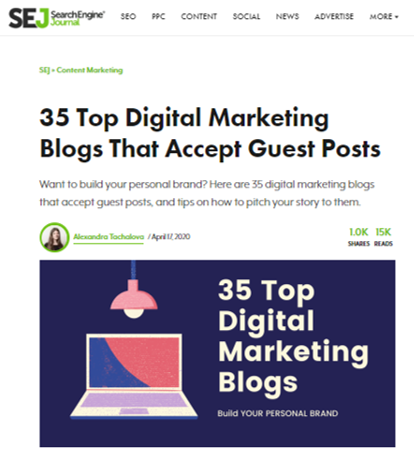Getting featured in the press is part of many companies’ communication strategies. It is related to marketing even more than you might think, as today we are talking more of an integrated communication (meaning a mix between marketing and PR) and not about separate, independent activities.
Media mentions can drive organic traffic to your website, increase your visibility, create social proof and help you rank better. Billionaire entrepreneur Richard Branson said, “publicity is absolutely critical. A good PR story is infinitely more effective than a front page ad.”
Here’s what you should know and take into account when working with the press.
First of all, you should decide on the format. You can choose, for example, to send press releases, to pitch journalists for special, dedicated materials or you can publish guest posts.
In any case, these materials should be an integrated part of your bigger communication strategy. Imagine your marcom activities as a flow, as a story and not as separated actions you only pursue when you have some news.
But how can you convince journalists to publish any of these materials?
Research
As with any marketing activity, you must do your homework. Research publications that either write about your specific industry or about larger topics that can include yours. Then, research journalists. See what they had been writing about, what they are interested in, what’s their angle. It’s not just useless to pitch a fashion journalist about technology, but it will also make you look unprepared.
If you’re going for a guest post, most blogs/publications have clear guidelines. For example, the article we wrote for Einstein Marketer follows their strict instructions you can either find on their website or have them sent to you by their team.
Also, research for those publications your target audience reads! You want to avoid sending pitches to media outlets that are not fit for your (and their) audience, which will show no return on your time investment.
How do you pitch them?
First of all, start drafting your database with the name of the publication, their website, the name of 1-2 journalists from that publication and their email address. You can use Hunter.io, the Chrome extension, to find their emails. But there are some publications that have contact infos for their staff and it is better to use those.
Some PR professionals choose to send press releases by BCCing more journalists or by adding them in newsletter databases. You can also use tracking tools, such as HubSpot, that allow you to see when or if they opened those emails, so you can follow up .
In contrast, if you pitch an interview/a dedicated piece, never BCC journalists! Show that you are interested in having a material exclusively written for them and the publication they represent.
First of all, they must open your email
If you’re running ads, you probably already know how important the title is. A strong subject line will increase your chances of being published. Here are some suggestions of how you should write your subject lines from Buzz Stream:
What next?
If you’ve convinced them to open your email, the next step is to get their attention with its content. We personally prefer a friendly, open, but respectful attitude. Your email should contain the most important information from the press release, summed up in 2-3 paragraphs.
Even if you pitch a press release or an interview, try to focus on the benefits you can offer your target audience, the impact you/your business has, the unique characteristics that differentiate you from others on the market.
No matter what you choose, remember that no journalist owes you anything. If you do not want to pay for that article, you can only hope they will find it interesting enough and make room for it in their editorial calendar.
We will now talk about the 3 formats mentioned at the beginning of this article and walk you through some of the most important aspects you should take into consideration.
The press release
There are a couple of moments when a press release makes sense: when you launch something, when you have gathered some really cool data, when you announce a new feature, a new partnership, when you celebrate something etc.
Though are some that might state that the press release is dead, we don’t think that. It can offer you great coverage, the content is considered news so Google doesn’t see it as duplicated content and it can help you with your SEO and organic traffic.
When writing a press release, here’s what you should keep in mind:
- It is not solely a promotional material – if you make it too much about yourself, it might be considered advertising. Try to mix information about yourself with actual benefits you offer
- Including numbers helps – it’s not enough to write a beautiful story. A strong press release includes data, numbers, stats
- You need a strong title – something people might feel attracted to, but not a click-bait
- Include a quote from your CEO and, if possible, from other relevant stakeholders
- Always send 2-3 landscape pictures with that press release
- Include backlinks and a boilerplate (a short description of your company)
- Follow-up and monitoring are vital – the easiest monitoring tool you can use is Google Alerts
You can either send the press release to multiple journalists or you can choose certain platforms that do that for you or media agencies that are a source of news for journalists.
Interview Pitch
A dedicated material can be more complex and present new, more insightful views. These pieces are great for awareness and visibility, but it can also be more difficult to obtain them. Here’s what you should keep in mind:
- Pitch journalists who are interested in the topic and who are constantly looking for new perspectives in the industry you represent
- Pitch angles or topics they have not covered yet
- Focus on the impact this kind of article can bring – it might inspire other entrepreneurs, it might offer practical solutions to a certain problem, it might emphasize a certain opportunity etc.
- If you don’t know exactly how to pitch, be franc. Tell that journalist that you would like to discuss more about the way your company improves the lives of other people, i.e.. If you are honest, open and respectful, they will help.
- Always include backlinks, a short bio of the person giving the interview, a boilerplate and 2-3 pictures
Guest Post Pitch
Depending on your niche, there are several websites (blogs or publications) that accept guest posting. You can find various lists on Google, such as this, for digital marketing.

Your next step should be to research the most interesting ones and see what they have already written about. It’s no use in pitching a topic they have already covered. At least, find a new angle.
Then, as I have already mentioned, see if they have any guest posting guidelines. Some of them might even ask you to formulate your subject line in a certain way so that they see if you’ve read their instructions.
If a blog/publication accepts publishing your article, remember to insert 1-2 backlinks to your own website, but don’t make the whole piece about you! It might get rejected.
Some publications might ask for a few days exclusivity, which means you cannot publish the same article on your blog too just yet. After respecting the mentioned time, you can publish on your blog as well, but don’t forget to mention it was initially featured on another website. Also, as it is duplicated content, Google might not index it.
This is what you should know about getting featured in the media, in a nutshell. As we were saying at the beginning of this article, just getting published is not enough. That content should help you increase your visibility and ultimately, attract clients.





